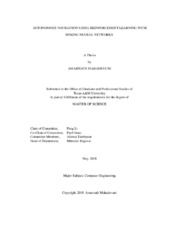| dc.contributor.advisor | Li, Peng | |
| dc.contributor.advisor | Gratz, Paul | |
| dc.creator | Mahadevuni, Amarnath | |
| dc.date.accessioned | 2019-01-17T16:14:58Z | |
| dc.date.available | 2020-05-01T06:23:19Z | |
| dc.date.created | 2018-05 | |
| dc.date.issued | 2018-03-13 | |
| dc.date.submitted | May 2018 | |
| dc.identifier.uri | https://hdl.handle.net/1969.1/173294 | |
| dc.description.abstract | The autonomous navigation of mobile robots is of great interest in mobile robotics. Algorithms
such as simultaneous localization and mapping (SLAM) and artificial potential
field methods can be applied to known and mapped environments. However, navigating in
an unknown, and unmapped environments is still a challenge. In this research, we propose
an algorithm for mobile robot navigation in the near-shortest possible time toward a predefined target location in an unknown environment containing obstacles. The algorithm
is based on a reinforcement learning paradigm with biologically realistic spiking neural
networks. We make use of eligibility traces that are inherent to spiking neural networks to
solve the delayed reward problem implicitly present in reinforcement learning. With this
algorithm, we achieve a set of movement decisions for the mobile robot to reach the target
in the near-shortest time. | en |
| dc.format.mimetype | application/pdf | |
| dc.language.iso | en | |
| dc.subject | Autonomous navigation | en |
| dc.subject | Spiking Neural Networks | en |
| dc.title | Autonomous Navigation Using Reinforcement Learning with Spiking Neural Networks | en |
| dc.type | Thesis | en |
| thesis.degree.department | Electrical and Computer Engineering | en |
| thesis.degree.discipline | Computer Engineering | en |
| thesis.degree.grantor | Texas A & M University | en |
| thesis.degree.name | Master of Science | en |
| thesis.degree.level | Masters | en |
| dc.contributor.committeeMember | Talebpour, Alireza | |
| dc.type.material | text | en |
| dc.date.updated | 2019-01-17T16:14:58Z | |
| local.embargo.terms | 2020-05-01 | |
| local.etdauthor.orcid | 0000-0002-9338-9419 | |


